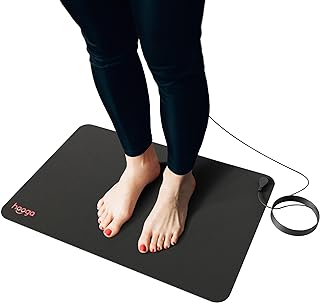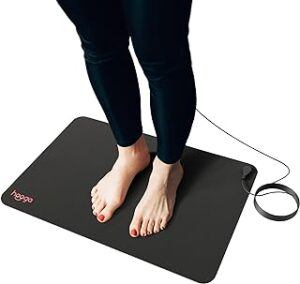A Comprehensive Guide to Finding Inner Peace Grounding and Earthing for Anxiety Relief
We are living in such a fast-paced world, it is no wonder that so many of us are feeling anxious and stressed out. Let us explore a variety of calming techniques designed to alleviate anxiety and promote a sense of inner peace. Whether you’re dealing with everyday stressors or more persistent anxiety, incorporating these techniques into your routine could make a significant difference in your overall well-being.
These are the common symptoms associated with anxiety:
Excessive Worry: Constant, uncontrollable, and disproportionate worry about various aspects of life, such as work, relationships, health, or everyday events.
Restlessness and Irritability: Feeling on edge, restless, or agitated, accompanied by irritability or a sense of being easily annoyed.
Physical Tension: Muscle tension, headaches, or other physical symptoms of stress without a clear medical cause.
Fatigue: Feeling persistently tired or fatigued, even after adequate rest, due to the heightened state of alertness associated with anxiety.
Sleep Disturbances: Difficulty falling asleep, staying asleep, or experiencing restless sleep. Nightmares may also be common in individuals with anxiety.
Difficulty Concentrating: Finding it challenging to focus on tasks or make decisions, as the mind is preoccupied with anxious thoughts.
Increased Heart Rate and Breathing: Physical symptoms such as a racing heart, shortness of breath, chest tightness, or palpitations, often associated with the body’s “fight or flight” response.
Gastrointestinal Issues: Stomach aches, nausea, digestive issues, or a feeling of “butterflies” in the stomach.
Sweating and Trembling: Experiencing excessive sweating, trembling, or shivering, especially in situations that trigger anxiety.
Avoidance Behaviour: Avoiding situations or activities that may cause anxiety, leading to a restriction in daily activities and potential social withdrawal.
Excessive Self-Consciousness: Constantly worrying about how one is perceived by others, leading to heightened self-consciousness and fear of embarrassment or judgment.
Panic Attacks: Sudden and intense episodes of extreme fear or discomfort, accompanied by physical symptoms like a racing heart, sweating, trembling, shortness of breath, and a feeling of impending doom.
Disclaimer: Everyone experiences anxiety differently, and symptoms can vary widely. Additionally, anxiety disorders can coexist with other mental health conditions, such as depression. If you or someone you know is experiencing persistent symptoms of anxiety that interfere with daily life, seeking professional help from a mental health professional is recommended. A mental health provider can offer a proper diagnosis and develop an appropriate treatment plan tailored to individual needs.
These are a few calming techniques for xnxiety – Grounding exercises, essential for anchoring yourself in the present moment. Where possible do these exercises outdoors ensuring you will be undisturbed and safe. If outdoors is not possible, use a earthing grounding mat to help anchor and calm you.
1. Mindfulness Meditation
Mindfulness meditation has gained popularity for its effectiveness in reducing anxiety. Begin your journey to inner peace with a simple mindfulness meditation. Find a quiet space, sit comfortably, and focus on your breath. Inhale deeply, exhale slowly, and let your thoughts come and go. Gradually increase the duration as you become more comfortable with the practice. Enhance your meditation by incorporating an earthing grounding mat.
2. Deep Breathing Exercises
Deep breathing is a powerful tool to calm the nervous system and reduce anxiety. Try the 4-7-8 breathing technique: inhale for a count of four, hold your breath for seven counts, and exhale for eight counts. Repeat this cycle several times, feeling the calming effects with each breath.
3. Progressive Muscle Relaxation (PMR)
Progressive Muscle Relaxation is a technique that involves tensing and then relaxing different muscle groups, promoting physical and mental relaxation. Practice PMR by starting with your toes, tensing the muscles for a few seconds, and then releasing. Move up through your body, addressing each muscle group.
4. Guided Imagery and Visualization
Using the power of imagination, guided imagery and visualization can transport individuals to a calmer mental space. Find a comfortable position and visualize a serene place, such as a beach or a forest. Engage your senses in the visualization, feeling the textures, smells, and sounds.
5. Incorporating Nature into Your Life
Nature has a profound impact on mental well-being.
Barefoot Connection:Combine the benefits of a nature walk with grounding by walking barefoot on natural surfaces. Feel the earth beneath your feet and embrace the grounding sensation. Use your senses to connect with the environment. If you’re indoors, bring a touch of nature to your space through potted plants or nature-inspired décor and sit or lie down on a grounding mat.
6. Journaling for Emotional Release
Expressive writing can be a therapeutic outlet for managing anxiety. Start a journaling practice by writing about your feelings and experiences. Use it as a space to release any pent-up emotions and gain clarity.
7. Yoga and Tai Chi for Mind-Body Harmony
Physical activities such as yoga and Tai Chi enhance flexibility and strength while contributing to mental well-being. Attend a local class or follow online tutorials to incorporate these mind-body practices into your routine.
8: Grounding Products
I would definitely recommend getting yourself a earthing grounding mat / linen for your bed, a mat to sit on and there are mats for your mouse pad as well. There are many company’s that I found that are selling these mats but they can be quite expensive. Click here for a selection of grounding and earthing products.
As you explore these calming techniques and grounding exercises, remember that consistency is key. Find what resonates with you and create a personalized routine to cultivate lasting inner peace and to regain control over your mental well-being. Try all techniques from mindfulness meditation to nature immersion and see what works for you. Finding the right combination of techniques may take time, so be patient with yourself and see this as a journey toward inner peace.






